Bulletin – December 2018 Finance The Reserve Bank's Securitisation Dataset
- Download 491KB

Abstract
The Reserve Bank's Securitisation Dataset contains timely and detailed data on each and every one of the mortgages underlying Australian residential mortgage-backed securities (RMBS). This dataset allows the Bank to better analyse the structure of, and monitor developments in, the mortgage market. In order to examine how representative the dataset is of the wider mortgage market we compare the dataset to less frequent but more comprehensive data from the Australian Prudential Regulation Authority (APRA). We find that the Securitisation Dataset provides excellent coverage of the collateral underpinning the RMBS market, and is representative of the wider Australian mortgage market across a number of dimensions. We then use these data to explore trends in mortgage interest rates.
Introduction
Housing assets make up just over half of the wealth of the average Australian household.[1] For the typical household, their dwelling is the largest asset they will buy over their lifetime.[2] Moreover, over two million Australians have an interest in an investment property.[3] As many residential investments are financed by mortgages, a key channel of monetary policy is through its effect on the mortgage market.
The Reserve Bank's visibility of the mortgage market has improved over recent years due to the collection of the Securitisation Dataset – a timely dataset that contains information on roughly one-quarter of Australian mortgages. The primary purpose of this dataset is to track the quality of RMBS that are eligible for use in the Reserve Bank's market operations. An RMBS is a collection of bonds ‘backed’ by a pool of mortgages, where principal-and-interest payments on the mortgages are passed through to bondholders.[4]
This article first discusses the Securitisation Dataset, with special emphasis on examining how accurately it represents the mortgage market. We find that the dataset is useful for monitoring average interest rates and the composition of lending, but it is not very useful for monitoring arrears rates. We then use these data to explore some structural features of mortgage interest rates, gaining insights that are not available using other datasets.
What is the Securitisation Dataset?
The Reserve Bank accepts certain highly rated asset-backed securities as collateral in its domestic market operations.[5] Since June 2015, the Reserve Bank has required that detailed information about an asset-backed security's structure and its underlying assets be made available – both to the RBA and to permitted data users – in order for the security to be eligible as collateral in the Reserve Bank's market operations.[6]
Approximately 98 per cent of the asset-backed securities submitted to the RBA are backed by residential mortgages. As a result, the RBA receives data on around 1.7 million mortgages with a value of around $400 billion. These data, which are submitted on a monthly basis, form the Securitisation Dataset, and represent roughly one-quarter of the total value of housing loans in Australia. In particular, the data include around 120 fields for each securitised mortgage, including the loan balance, the term of the loan, repayment amounts and information about the borrower and the property. These data allow the Reserve Bank to manage its actual and contingent exposure to these securities through its market operations. The dataset also allows the Reserve Bank to gain insights into developments in the residential mortgage market that are not readily available from other sources.
Approximately 94 per cent of the dataset comprises loans made by Authorised Deposit-taking Institutions (ADI). While ADIs fund only 4 per cent of their mortgages by selling RMBS to investors, the large share of ADI loans is because the dataset includes ‘self-securitisations’. Self-securitisations are not sold to investors, but are instead held entirely by the originating ADIs for use as collateral in the Reserve Bank's market operations, particularly for the Committed Liquidity Facility (CLF).[7] These self-securitisations represent three-quarters of all loans in the dataset (four-fifths by value, Graph 1). The remaining securitisations, which are sold to investors, are referred to as ‘marketed deals’.
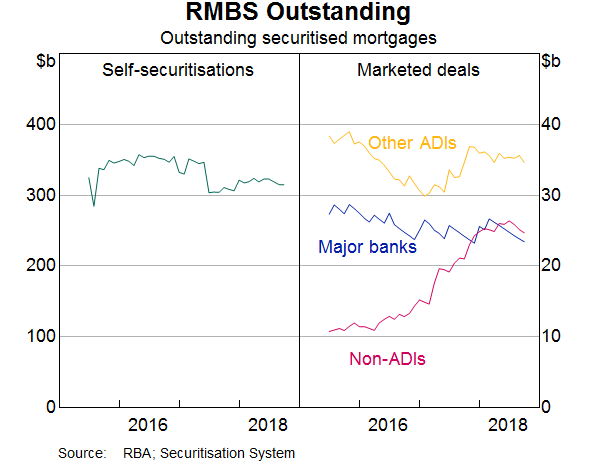
Is the Dataset Representative of the Broader Mortgage Market?
Before drawing inferences from the Securitisation Dataset for the broader Australian mortgage market, it is important to confirm that the dataset is reasonably representative of it. Despite the large volume of mortgages in the dataset, it is possible that the characteristics of the loans in the dataset could be different from other loans. There are several factors that could affect the representativeness of the dataset.
The first is that issuers of both marketed deals and self-securitisations face incentives to select certain types of loans to put into securitisation pools. All RMBS in the dataset must be rated by credit rating agencies. These agencies are less likely to issue high ratings if they consider the collateral to be of sub-par quality. For example, high concentrations of loans to investors, borrowers with little to no income verification, and loans requiring only interest payments make it more difficult to attract a high rating. Issuers may decide to exclude these loans from their deals as otherwise they will have to provide additional ‘credit support’ to achieve the required high ratings.[8] Also, the Reserve Bank has requirements for a security's eligibility for purchase under a repurchase agreement (repo) that may affect the composition of RMBS. In particular, the Reserve Bank discourages the inclusion of loans with little to no income verification and those ineligible for lenders' mortgage insurance. Investor preferences are also likely to play a role; if RMBS investors prefer certain types of loans, it is more likely that they will be selected into securitisations.
Another selection effect that may be relevant relates to the ‘originate-to-distribute’ model of funding. If an institution originates a loan and sells off its entire exposure, then it may have less interest in how that loan performs. If this type of selection were to occur, we might expect to see securitised loans being of lower credit quality than loans retained on the issuing institution's balance sheet.[9] However, this is unlikely to be a concern for self-securitisations, which form the bulk of the Securitisation Dataset.
The timing of loans entering and exiting the database could also affect the representativeness of the data. There are often significant lags between loan origination and when a loan is first placed in a securitisation pool. There are further lags between securitisation and submission to the Securitisation Dataset – as a deal must be assessed against the RBA's repo-eligibility framework before being accepted. This will typically lead the dataset to contain relatively few loans that have been originated recently.
The types of institutions who are more likely to securitise loans can also affect the sample of loans observed in the dataset. In particular, ADIs typically securitise and sell a relatively small proportion of their mortgages as they have access to other funding sources, such as deposits. In contrast, non-ADIs rely on securitisation for funding and typically securitise most of their mortgages. As a result, a mortgage originated by a non-ADI is more likely to end up in the dataset than one originated by an ADI.
Self-securitised deals have revolving pools – the originating ADI has the ability to add or remove loans from the pool – which may affect the sample. For example, if issuers were to remove loans in arrears from their self-securitised deals in order to maintain a high-quality pool, then this type of mortgage would be under represented. On the other hand, the revolving nature of the pool means that self-securitised loans enter the dataset sooner after origination than for marketed deals, offsetting the bias against new loans in marketed deals where the pool of loans is static.
Despite these effects, the dataset is particularly good for studying the non-ADI sector and the securitisation market as a whole (as opposed to the mortgage market). This is because the Securitisation Dataset provides excellent coverage of the Australian RMBS market, containing 96 per cent of Australian RMBS issued publicly in 2016 and 2017.[10] Nonetheless, lags between loan origination and their appearance in the dataset may limit inferences that can be made about newly originated loans.
Comparison against broader mortgage market
By comparing some key characteristics of loans issued by ADIs in the dataset (hereafter ADI sample) against the same metrics for the broader population of ADI mortgages (hereafter ADIs' balance sheets) we can get a sense of whether the Securitisation Dataset is representative of the overall mortgage market.
The ADI sample from the dataset appears to be appropriate for drawing inferences about trends in loan types, such as whether the loan is to an owner-occupier or investor; and whether the loan payments are on a principal-and-interest or interest-only basis. We find that, on average, loans in the ADI sample are somewhat more likely to be made to owner-occupiers who pay principal and interest than other loans on ADIs' balance sheets (Graph 2). Conversely, the share of interest-only investor loans is lower than the share on ADIs' balance sheets. Despite these differences in shares, the changes in shares by loan types in the ADI sample from the dataset broadly track the trends for ADIs' balance sheets quite closely.
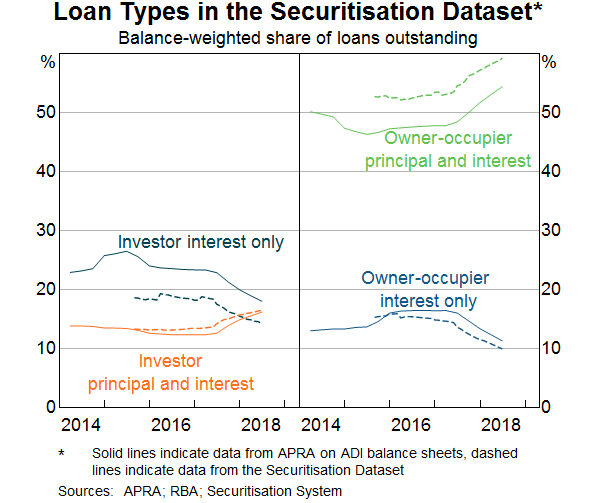
Differences in levels can be seen in some other loan characteristics (Table 1):[11]
- The share of new loans originated with loan-to-valuation ratios (LVRs) greater than 80 per cent was 11 per cent, below the 19 per cent share for the broader mortgage market. This is likely to reflect the fact that ratings agencies discourage high-LVR loans.
- Loan balances in the dataset tend to be around $25,000 (or 9 per cent) smaller, across both owner-occupiers and investors.[12]
- The share of loans in the dataset with reduced (or low) borrower income documentation is a percentage point higher than the 1.3 per cent of loans on ADI balance sheets.
- There are fewer fixed-rate loans in the dataset (13 per cent) than there are in the broader population (21 per cent). Variable-rate loans are preferred for securitisations because the income stream they provide matches the variable-rate interest payments on the securities issued by securitisation vehicles.
| Indicator | ADI sample in Securitisation Dataset | ADI data reported to APRA(a) |
|---|---|---|
| Share of owner-occupied, principal–and-interest loans | 59% | 54% |
| Average loan balance | $248,000 | $273,000 |
| Newly originated loans with LVR over 80 per cent | 11% | 19% |
| Non-performing loans | 0.5% | 0.9% |
| Reduced documentation loans | 2.3% | 1.3% |
| Fixed-rate loans | 13% | 21% |
| Average outstanding interest rate | 4.41% | 4.36% |
|
(a) Via APRA forms 220.0, 320.0, 320.8. Sources: APRA, RBA, Securitisation System |
||
The dataset provides a timely indicator of average variable interest rates. This is particularly valuable as there are few other data sources that provide information on actual interest rates paid by borrowers.[13] Currently, the average interest rate in the dataset is around 10 basis points above the average rate for mortgages on ADIs' balance sheets, which has been reasonably stable over the available observations (Graph 3). This stability suggests that we can use these data to analyse trends and, to some extent, also levels of interest rates. However, we need to exercise caution when analysing certain narrow sub-samples of the dataset; for instance, the sample size of recently originated loans is quite small and is weighted towards certain issuers due to the delay between loan origination and entry into the database.
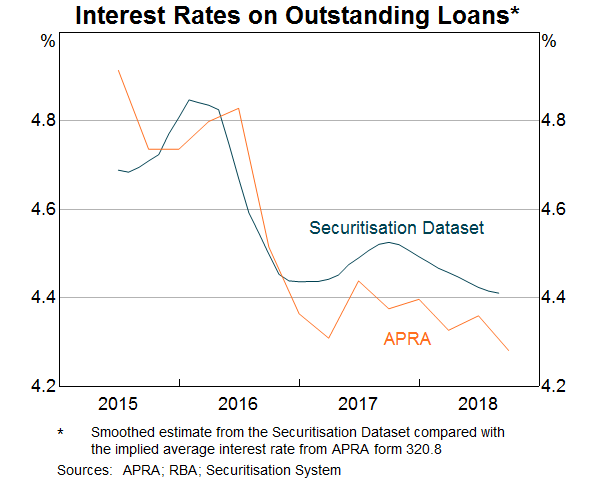
The share of loans that are in arrears (or are otherwise non-performing) is significantly lower in the Securitisation Dataset than on banks' broader balance sheets: the rate of non-performing loans stands at around half a percentage point, compared to 0.9 per cent for loans in the broader population. This is primarily due to the revolving pool underlying self-securitisations as some banks tend to remove loans in arrears from their self-securitised pools.
We have not compared loans from the non-ADI sector due to a lack of data to compare the dataset against. However, as many non-ADI lenders fund their lending primarily using securitisation we are satisfied that the dataset contains a fairly representative sample of their lending.[14]
Putting this all together, it appears the dataset is useful for monitoring trends in the mortgage market, for example, interest rates and shares of interest-only and investor loans. It is particularly good for studying developments in the non-ADI sector and the securitisation market as a whole. But care must be taken where there is selection bias in the loan pool when drawing inferences about the broader mortgage market; this is particularly the case when examining arrears rates in the dataset.
Insights from the Dataset on Mortgage Interest Rates
As a result of the dataset's coverage, the Reserve Bank has been using it to monitor mortgage interest rates as part of its regular analysis of financial sector developments. It is particularly useful for examining sub-samples of the data not available from other sources, although the caveats mentioned above need to be considered.
Since data collection began in mid 2015, average interest rates for loans in the dataset have generally been trending down (Graph 4). This was driven by lower funding costs for issuers as the cash rate declined, and changes in the composition of lending in the ADI sector towards principal-and-interest loans and owner-occupier lending (which have lower interest rates). Events which affected interest rates can be clearly seen in the data, such as the introduction of regulatory measures in late 2015 and the further tightening of these measures over early 2017. We can also observe the effect of increases in wholesale funding costs over 2018, which led to increases in interest rates firstly in the non-ADI sector (which is more dependent on wholesale funding markets) and then later in the ADI sector.
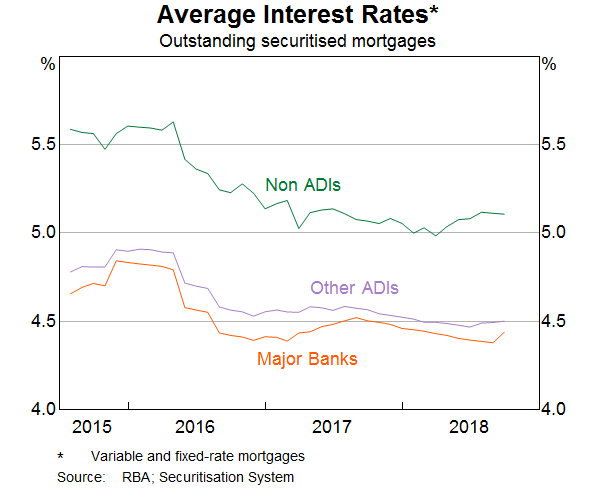
This average trend masks significant shifts in interest rates paid by certain borrowers. For example, interest rates paid by investors or by borrowers who have an interest-only loan increased notably in late 2015 and over 2017 in response to regulatory measures (Graph 5).
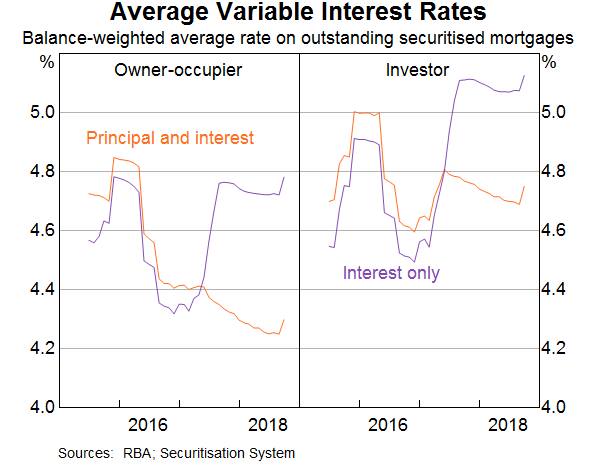
The dataset also allows us to examine the full distribution of interest rates paid on mortgages. While there may be some caveats on representativeness, we believe the dataset does deliver useful insights along this dimension, provided we focus on large enough sub-samples. The dataset shows that ADIs offer a wide range of interest rates on loans, with interest rates varying from 3.5 per cent to 6 per cent (Graph 6). This is likely to reflect differences in borrower characteristics, competitive pressures (as more recently originated loans have lower interest rates) and differences between lenders.
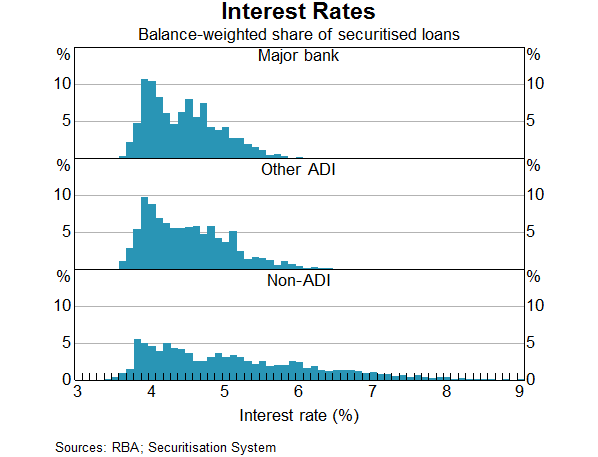
The distribution of interest rates in the non-ADI sector is wider, reflecting the variety of lenders in this sector. Some non-ADIs specialise in lending to high-quality borrowers and have a similar interest rate distribution to the ADI sector. Others specialise in providing riskier loans, such as to borrowers who have impaired credit histories or no income verification and therefore have higher average interest rates.
Few borrowers in the dataset appear to pay advertised standard variable interest rates, as unadvertised discounts are offered to most borrowers (Graph 7). This highlights the importance of examining data on actual interest rates paid rather than advertised rates. Standard variable rates can significantly overstate interest rates in the market. Moreover, as discounts fluctuate through time, standard variable rates give an incomplete picture of movements in actual mortgage rates.
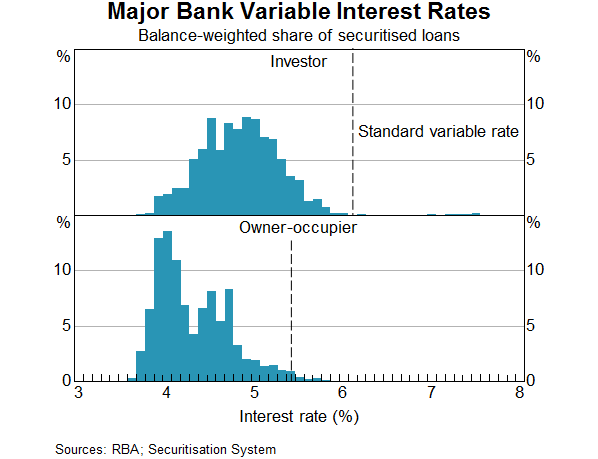
Many of these insights would not have been available without the Securitisation Dataset, and they certainly would not have been available in such a timely manner. In a relatively short period of time, the dataset has been integrated into the broader set of data that the Reserve Bank uses to monitor the economy. It has also been useful for analytical work, for an example see Bergmann and Tran (2018). The Bank will continue to use these data, and explore other questions that it can help address.
Footnotes
The authors are from Domestic Markets department. The authors would like to thank Michelle Bergmann and Amelia Dakin for their contributions to this article. [*]
See ABS (2018), available at <http://www.abs.gov.au/ausstats/abs@.nsf/Lookup/by Subject/6523.0~2015-16~Feature Article~Household Debt and Over-indebtedness (Feature Article)~101>. [1]
See ABS (2017), available at <http://www.abs.gov.au/ausstats/abs@.nsf/Lookup/by Subject/6523.0~2015-16~Main Features~Household Income and Wealth Levels~5>. [2]
See the ATO's 2015-16 taxation statistics, table six on the ATO's website, available at <https://www.ato.gov.au/About-ATO/Research-and-statistics/In-detail/Taxation-statistics/Taxation-statistics-2015-16/?page=6>. [3]
For more information about asset-backed securities see Arsov, Kim and Stacey (2015). [4]
Thirty-two per cent of all Australian dollar securities held under repurchase agreements (repos) were asset-backed securities in FY2018 (RBA, 2018a). For more information about the RBA's domestic market operations see RBA (2018b) and RBA (2018c). [5]
For more information on permitted data users see RBA (2018d). [6]
The RBA provides the CLF. It allows ADIs to access liquidity by pledging eligible securities for repo. This contributes to their ability to meet their Basel III liquidity requirements as expressed by APRA. See RBA (2011) for more information. [7]
Credit support for a given tranche is the amount of losses a securitisation can sustain before that tranche begins to see losses. For example, if a tranche had 20 per cent credit support, this means that 20 per cent of loans in the securitisation could default with 100 per cent losses before that tranche is affected. For more information on tranching, see Arsov, Kim and Stacey (2015). [8]
There may also be counterweights to this effect. For example, issuers may want to avoid a reputation of backing their securitisations with poor quality collateral. [9]
Of course, it is possible there are some selection effects at play in the types of deals that do not seek RBA repo eligibility; however, given the small size of these, any effect on the representativeness of the data is expected to be minor. [10]
As the sample of ADI loans consists largely of self-securitisations, these differences are generally true for that particular subsample. [11]
This calculation is not adjusted for split loans. A loan is split, for example, when there is a fixed and variable-rate component to a mortgage. [12]
Other measures of mortgage interest rates, such as standard variable rates and other advertised rates, are not good proxies for actual interest rates paid as they do not account for unadvertised discounts commonly offered to borrowers. For further analysis on interest rates using the Securitisation Dataset see Kohler (2017) and Bergmann and Tran (2018). [13]
Some of the largest firms in the non-ADI market (Firstmac, Resimac, and Liberty Financial) fund close to their entire loan books via marketed securitisation. See KangaNews (2018), available at <http://www.kanganews.com/magazine/720>. The dataset will not contain recently originated loans in warehouse facilities, which may limit inference about recent lending from this sector. [14]
References
Bergmann M and Tran M (2018), ‘The Distribution of Mortgage Rates’, RBA Bulletin, March, viewed 28 November 2018.
Arsov I, Kim IS and Stacey K (2015), ‘Structural Features of Australian Residential Mortgage-backed Securities’, RBA Bulletin, June, viewed 29 November 2018.
Kohler M (2017), ‘Mortgage Insights from Securitisation Data’, Speech at the Australian Securitisation Forum, Sydney, 20 November.
ABS (Australian Bureau of Statistics) (2018), ‘Household Income and Wealth, Australia’, Tenure and Landlord Type Data Cube, ABS Cat No 6523.0, 2015-16, July. Available at <http://www.abs.gov.au/AUSSTATS/abs@.nsf/DetailsPage/6523.02015-16?OpenDocument>.
ABS (2017), ‘Household Income and Wealth Levels’, Household Income and Wealth, Australia, 2015–16, September. Available at <http://www.abs.gov.au/ausstats/abs@.nsf/Lookup/by%20Subject/6523.0~2015-16~Main%20Features~Household%20Income%20and%20Wealth%20Levels~5>.
RBA (Reserve Bank of Australia) (2018a), Annual Report 2018, September, pp 58.
RBA (2018b), ‘Domestic Market Operations’.
RBA (2018c), ‘How the Reserve Bank Implements Monetary Policy’.
RBA (2018d), ‘Securitisations Industry Forum Reporting Guidelines’.
RBA (2011), ‘The RBA Committed Liquidity Facility’, Media Release No 2011.25, 16 November.
ATO (Australian Taxation Office) (2018), ‘Taxation Statistics 2015–16’, ato.gov.au site, 3 July. Available at <https://www.ato.gov.au/About-ATO/Research-and-statistics/In-detail/Taxation-statistics/Taxation-statistics-2015-16/?page=6#Table6>.
KangaNews (2018), ‘Nonbank Yearbook’, supplement to the KangaNews October/November 2018 issue, November. Available at <http://www.kanganews.com/magazine/720>.